How to connect a heated towel rail to the DHW riser and a heating circuit with your own hands
The device for drying hygiene items and removing excess moisture in the bathroom is simple both in the device and in the installation. In order to carry out its installation, fundamental knowledge in the field of construction of engineering communications is not needed.
However, you should clearly know how to connect a heated towel rail. After all, the result of your own efforts or the work of hired plumbers should please for many years, do you agree?
In the article we presented, all the options for installing the PS and possible complications during its connection are discussed in detail. Checked and systematized information will become a reliable tool for home craftsmen who want to do the work themselves, or who seek to control the actions of workers.
We described in detail the specifics of connecting an important appliance in the bathrooms in the bathrooms of the old and new layout. We did not disregard the problems of owners of private houses. The information we have proposed is verified in practice, supported by visual materials and video instructions.
The content of the article:
Specificity of installation of a heated towel rail
General connection principle any kind heated towel rail remains unchanged: water is supplied at one end, and outflow occurs at the other. Installation of PS requires mandatory consideration of the moments dictated by the installation features.
When connected to a hot water supply or central heating system, it becomes part of the pipeline. If the insertion is wrong, then the problems that arise will concern not only a separate apartment, but all others located along this riser.
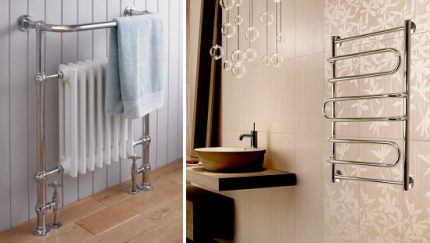
To avoid electrolytic corrosion, it is recommended to use parts made of the same material.The exception is plastic pipes, a plumbing fixture made of any material will suit them.
For our water system is better choose a heated towel railissued by domestic manufacturers and complying with regulatory documents. One should be careful with imported models - most of them are designed for other standards.

Heated towel rail, having the form of a ladder, is connected to the pipeline by several methods - vertical, diagonal, lateral. The main thing is to maintain a center distance of 50 cm.
When inserting into an existing system, its parameters must be taken into account. The distance from the riser to the newly installed unit must not exceed 200 cm, otherwise significant heat loss cannot be avoided.
Ideal when pipe system and heated towel rail coincide in diameter, if they do differ, the connection is made through adapters.
The pipes of the device can be larger in diameter than the pipes of the existing circuit, but in no case less. This will allow not to create excessive hydraulic pressure and ensures normal circulation of the coolant in the system.
A selection of photos will familiarize you with the features of connecting the PS to the DHW systems:
So that the device, if necessary, can be easily removed, move to another wall it is necessary to use detachable couplings with an internal thread like American to connect it to the riser. It is necessary to strive to reduce the number of adapters, because leaks may occur at their locations.
Joints should be sealed with special compounds or winding, and save on this is not worth it. Conventional metric threads seal winding from flax. Tapered threads are best sealed using FUM tape. The twisting should be carried out with a slightly tangible tight fitexcessive efforts are unacceptable.
Picking up cranes and fitting, take an interest in their electrochemical compatibility so that it does not happen that upon contact they will create a galvanic pair. A combination of steel and brass has this property. Corrosion occurs quickly and the assembly becomes unusable.

If a plumbing fixture is part of a riser, then no locking devices may be installed on it. To make it possible to disable heated towel rail without overlapping the entire riser, it is necessary to include a bypass in the system - a jumper connecting the branches from the riser towards the device.
Ball valves are installed after this jumper. When the connection pipes are cut into the riser, it itself acts as a bypass.
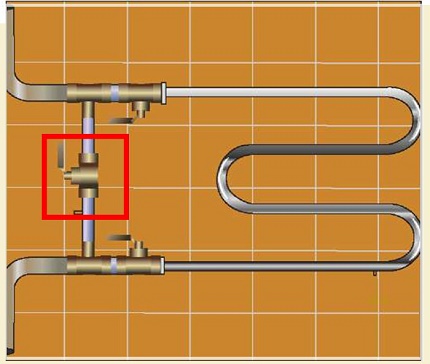
Connection PS to DHW or central heating
Connection heated towel rail to the risers of the central networks can be performed in different ways.
The tactics of the work depend on the modification of the coil:
- Top connection. Water flows from above, and the return is located below.
- Bottom connection. The coolant enters on the one hand, and is discharged on the other.
- Diagonally. Approach from above, tap below from the opposite side.
- In the lower part of the device in the center.
Regardless of where the PS is connected - to the system FGP or to the central heating riser, similar schemes are used.

Installation heated towel rail in the riser
To embed heated towel rail in the bathroom located in the apartment of a multi-storey building, it is necessary to turn off the hot water in the riser. The task is facilitated if the unit can be dismantled by simply unscrewing the nuts connecting it to the common pipe. The main thing is that the connecting pipes of the new device should have similar dimensions.
When the old-style appliance is welded to the riser, it is more difficult to disconnect it. The best solution is when connecting heated towel rail do it yourself replace and riser - partially or completely. The second option is preferable. Pieces of old pipe left in the ceilings pose a potential threat.
The riser, together with the old unit, is cut with a grinder, then the pipe thread of the neighbors is cut from above and below, a new riser is connected and taken out to its room.
Using polypropylene pipes with the same diameter is preferable to steel. They are cheaper, lighter, not subject to corrosion, resistant to high temperatures, durable.
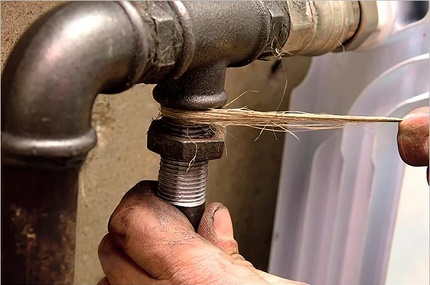
There is a large selection fittings for PPP pipes that welded into the riser to go to the thread and connect heated towel rail.
For soldering use special soldering iron. Many arrange a box to hide the wiring behind it, without changing the connection diagram.
Do-it-yourself installation PS simple configuration
The dryer is assembled, shut-off valves are mounted on the eyeliner using detachable connections, then they are tried on a pre-marked place on the wall, horizontality and verticality are checked, the brackets for PS fasteners are fixed.

Connection is performed according to the following technology:
- Install bypassusing pipes or tees. In places where it is connected to the device, one valve is installed.
- Fasten heated towel railusing brackets or other hardware.
- Connect the device to the valvesapplying bushings or fitting connections.
- Slowly open the taps and fill the unit with water.
Bypass in this circuit performs an important function - it provides the same temperature of the supplied coolant in all apartments located along the riser. Ball valves allow you to optionally turn off the device or even completely remove it, install a thermostat on itmaintaining the set temperature.
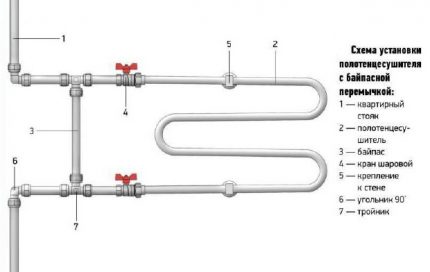
Many, trying to optimize the circulation of the coolant through the dryer, make it biased or choose a pipe with a diameter one order smaller than the lead. Professionals consider this approach unjustified. In a device with a simple configuration, good circulation is also observed with direct bypass.
This phenomenon can be explained using the laws of physics: the cooling liquid in heated towel rail has a larger specific gravity compared to a hotter heat carrier, so it rushes down.
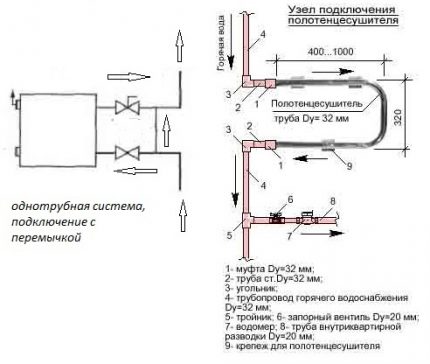
As a result, the cooled liquid is pushed into the central pipe from the bottom of the unit. The higher temperature fluid from the riser flows to the top heated towel rail and the cycle repeats. Cooled water here acts as a perpetual motion machine.
Some advise installing shut-off valves on the bypass to shut off the flow of water. But this contradicts the rule that in a multi-storey building no owner of the apartment should have any opportunity to block the central riser on their own and deprive everyone of hot water.
Another thing is a private house, here the owner can put the crane wherever he wants, but if the system is correctly balanced and there are thermostatic devices, then there is no need to install a crane on the jumper.
Not too aesthetically attractive open piping can be hidden:
Shutoff valves in front of the substation are needed in order to control its operation. Both ball and 2-position, multi-turn versions are suitable for this purpose. To remove air jams they are of little use.
While the products are new, this can be done by loosening the nuts, but because of this, the seals quickly become unusable. If, if there is a thread on the taps, it is not on the pipes, then it should either be cut or a suitable fitting welded.
Install in a new building heated towel rail The heating system is simpler, but it will only be warm in the heating season. Installation in SGV more effective.
Technology of working with the ladder model
On natural circulation, connection schemes can also work. heated towel rail “Ladder” to the riser, while the most commonly used, well-established, connections are lateral or diagonal.
For these schemes, neither the flow direction of the coolant in the riser, nor the circulation rate of the coolant play a role; airing systems in case of shutdown of water supply.

The connection sequence is the same as in the case of a simple configuration PS.
For the circuit to work, you need to consider some features:
- Above the riser, located at the top of the PS or above its upper point, and the one below - equal to or below the lower point.
- Observe strictly horizontal supply pipes or make a slope of 5-10 mm along the entire length. If this condition is not observed, air jams may occur. If you chose a lower feed, then using a pipe of a smaller diameter for a boypast is unacceptable.
- Choose pipes with a diameter of at least 25 mmif they are polypropylene, at least ¾ inch - steel, ball valves 3/4 ″ With smaller diameters, uneven heating will be observed - hotter above and colder below.
- Put plastic pipes in insulationif you planned to wall them up.
If you installed a narrowed bypass or displaced it, then natural circulation will work in conjunction with forced circulation. This scheme has a significant minus: complete inoperability with a lower connection, only the upper version is permissible.
There are also positive aspects: at top feed it works stably, not airs, heated towel rail can be removed from the riser at an arbitrary distance.
If you decide to make the lower connection, then be prepared for the fact that this method is less effective, but it also has some advantages: the direction of water supply in the central riser does not matter, it becomes possible to hide pipes under the bathtub.
The main disadvantage is the mandatory presence of a crane Mayevsky to release air. A prerequisite for the operability of the circuit is a lower tap device below the PS enclosure.
If desired, the lower connection can be redone in the side. For this, angles of 90 ° are mounted on the inlet and outlet pipes. The working section of the adapters should not differ from the diameter of the pipes in a smaller direction, otherwise the performance of the system will be violated. Reverse modernization - alteration of the side connection to the lower one is impossible.

Insert PS in the centralized heating system
If you want to complete the installation of a towel dryer in the winter, something is unlikely to work out of this venture. In this case, you will have to stop the heating and remove the coolant from the system, so you have to wait until the summer.
But even then, the work is complicated by the fact that the heating system must be emptied, and its recharge shut off. For all this you need to enlist the permission of the services Housing and communal services.
It is difficult to conduct a performance check of the PS in the summer. Defects in the form of leaks in the place of welds and threaded joints will manifest themselves only after connecting the heating. This fact once again testifies in favor of the mandatory installation of cranes after bypass.
Connection heated towel rail in a country house
The conditions of a private house are more favorable for the installation of a dryer. With an autonomous feed system, there is cleaner water. You can buy imported PS, afraid of sediment accumulation.
Typically, in such a house, a sufficiently large room is allocated for the bath, which expands the boundaries of the choice of the unit in size and shape. And for work on the connection does not need permission from neighbors.
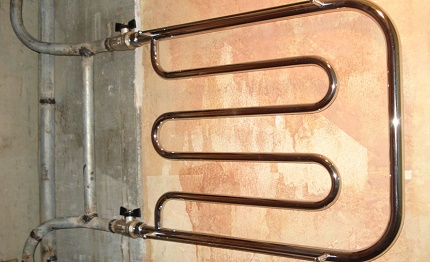
The connection scheme itself is similar to that used in an apartment building. It must be remembered that the device should only be connected in the direction of flow of water. With an eyeliner length of up to 50 cm, place the pipes horizontally, with a larger one, make a slope along the entire length.
Observe the distance between the wall and the water pipe. With a pipeline diameter of 4-5 cm, a distance of 5 to 5.5 cm is selected. When the diameter is less than 2.3 cm, this gap is reduced to 3.5 cm.
Considering the temperature deformations that hot pipes are subject to, it is impossible to fix PS on supports by welding, the fastening should be free.
Common mistakes of independent masters
When the bottom outlet is located above the end point of the PS during lateral or lower connection, a stagnant zone forms between the bottom of the device and the connection point of the lower outlet.
This is a consequence of the fact that the cooled liquid, having lowered down, cannot get into the riser because of the pressure on it of a column of hot water with a lower specific gravity. While the permissible height difference between the lower tap and the bottom heated towel rail not exceeded, the device is working, and after - the circulation in it stops.
Circulation will also stop if there is a knee formed by the upper tube. Only a sidebar can make such a scheme work crane Mayevskyto periodically bleed the accumulated air. Sometimes a loop is made in the upper pipe, laying it behind the ceiling sheathing, and the lower pipe is bricked into the floor.
Above, air will accumulate, and chilled water in the unit will be blocked in the lower loop located in the floor. The movement of the coolant will completely stop.
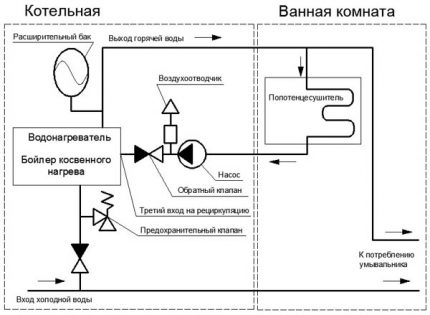
Conclusions and useful video on the topic
The process of installing the device in a new building before finishing work:
Video about errors in selecting and connecting a heated towel rail:
Wiring diagram heated towel rail can not be called complicated. It is quite doable for a home master. But neglecting the rules and even insignificant nuances, you can bring on yourself a lot of trouble.
Is there anything to supplement or have questions about the technology for connecting a heated towel rail? Please leave comments on the publication. The contact form is located in the lower block.

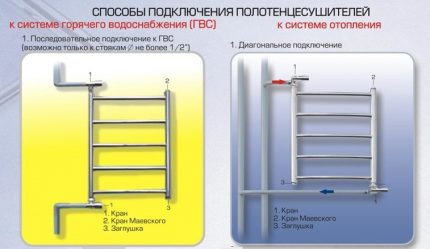
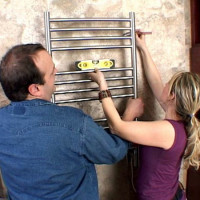 Installing a heated towel rail in the bathroom: DIY installation guide
Installing a heated towel rail in the bathroom: DIY installation guide 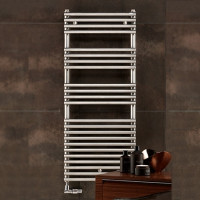 How to choose a heated towel rail for the bathroom: what to look at before buying + an overview of popular brands
How to choose a heated towel rail for the bathroom: what to look at before buying + an overview of popular brands 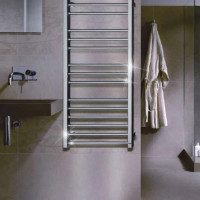 Which water heated towel rail is better: learning how to choose the right one
Which water heated towel rail is better: learning how to choose the right one 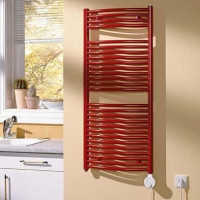 How to choose an electric heated towel rail for the bathroom: selection tips and best options
How to choose an electric heated towel rail for the bathroom: selection tips and best options  Transfer the heated towel rail to another wall in the bathroom: installation instructions
Transfer the heated towel rail to another wall in the bathroom: installation instructions 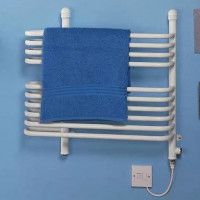 Connecting an electric heated towel rail: step-by-step installation instructions
Connecting an electric heated towel rail: step-by-step installation instructions  How much does it cost to connect gas to a private house: the price of organizing gas supply
How much does it cost to connect gas to a private house: the price of organizing gas supply  The best washing machines with dryer: model rating and customer tips
The best washing machines with dryer: model rating and customer tips  What is the color temperature of light and the nuances of choosing the temperature of the lamps to suit your needs
What is the color temperature of light and the nuances of choosing the temperature of the lamps to suit your needs  Replacement of a geyser in an apartment: replacement paperwork + basic norms and requirements
Replacement of a geyser in an apartment: replacement paperwork + basic norms and requirements
I really need the help of a professional. The fact is that during repairs in the bathroom, the heated towel rail was changed; when hot water was turned off, it drips from the lower connection. The PS is connected to the riser using an “American” type detachable coupling. The locksmith who installed says that if you tighten more, then everything can burst. Now when you turn off the water you have to put a bucket, but this does not solve the problem. What to do in this situation?
Inside the “American” brass, it has a different coefficient of thermal expansion with a pipe. The hot water was turned off, the temperature decreased and a small leak formed.You can’t determine how to fix it according to the words; Call the plumber if you are not confident in your abilities.
Hello. And what can be offered here, except for replacing the connecting elements or repairing them? If you have an apartment, contact the Criminal Code if you did not have an unauthorized installation of the substation. If the house - push the locksmith on the head, let him look for what the problem is. I forgot the gasket, I did not turn the plumbing thread or what else. Here on the face of poor-quality services and doing something yourself for you is impractical at all. Press the locksmith.
Our apartment has a rather spacious bathroom, and I have long wanted to have a voluminous, full-fledged heated towel rail in it. I asked my husband about this, but he did not dare to take up this work. And only after reading your article, he was inspired. When everything is clearly described, that is, confidence that the work will succeed. As a result, he made a wonderful “Ladder” with a side connection. Now we live and enjoy!
Please tell me whether it is allowed to install an American type connection on a heated towel rail according to GOST or SNiP.
Hello. “INTERNAL SANITARY AND TECHNICAL SYSTEMS OF BUILDINGS SNiP 3.05.01-85 SP 73.13330.2016” from paragraph 5.1
The only question is before the counter or after? They hit a friend so that the counter constantly shook. Redid to the counter, but now it is not clear who pays for the lost degree of water heating. One way or another, but nothing happens for free, which means someone has to pay for the heat received. Charged to common needs or what?
How can I connect a heated towel rail to a water meter? Such taps are generally illegal! If you mean connecting the PS before or after the counter, then in any case it will count no more and no less than what it consumed.
Often, PSs are connected after the water meter, so it’s more practical. For clarity, I am attaching several photos with connected PS to the wiring. If there are still questions, then form the details more clearly, I will try to answer them.